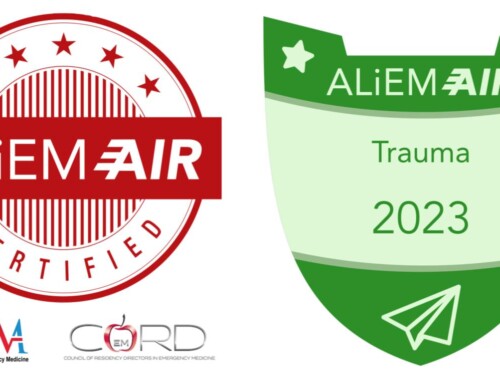 Ever wonder what would happen if you were working in the emergency department (ED) when a nuclear attack happens? We’ve all had questions on boards or inservice exams about the long-term effect of radiation exposure, but would you know what to ACTUALLY DO if a nuclear attack happened? What do you do in the first few minutes? First few hours? We know that if you are in the immediate bomb vicinity, there is not much you can do. But what if you are 5 miles away? Or 10 miles?
Ever wonder what would happen if you were working in the emergency department (ED) when a nuclear attack happens? We’ve all had questions on boards or inservice exams about the long-term effect of radiation exposure, but would you know what to ACTUALLY DO if a nuclear attack happened? What do you do in the first few minutes? First few hours? We know that if you are in the immediate bomb vicinity, there is not much you can do. But what if you are 5 miles away? Or 10 miles?
If you look for information regarding nuclear attacks, there are no great summary resources on what to do in the immediate aftermath if you are in the ED. In order to bring this to you in an easily digestible format, we have broken this post up into a few topic areas: This blog post will cover (1) what physically happens in a nuclear attack and (2) what this means in the ED.
1. What happens in a nuclear attack?

Photo credit from Gizmodo.com
The answer is that it depends on the strength of the bomb (megatons). The bomb that struck Hiroshima was 15 kilotons (kT), and the largest bomb detonated to date was the Tsar Bomba, at 50 megatons (mT) which is equivalent to 3,333 Hiroshima bombs.
There are 2 phases of attack with a nuclear weapon:
Phase 1: Direct effects from the explosion
When a nuclear bomb explodes on the ground, it essentially vaporizes everything within a certain radius, depending on the size of the bomb. These vaporized particles form the characteristic mushroom cloud. If you are at ground zero, there is nothing you can do, and death will be quick. But what if you are not in the direct path but near it? Nuclear bombs can still have adverse effects miles away. To understand these effects, we need to understand what nuclear bombs actually do.
The 5 main initial effects of a nuclear bomb are:
- Radiation – Highly penetrating gamma rays are emitted upon explosion. This is referred to as initial nuclear radiation.1 These gamma rays are emitted as a one-time dose that moves through but does not persist in the environment. There is a risk of ongoing radiation exposure, but that is due to the presence of radioactive particles from fallout and not the initial radiation dose. Additionally, infrared radiation can also cause burns as exposed skin absorbs the infrared radiation. This can occur at lower temperatures than would cause clothing to ignite.2
- Fire – As the explosion is occurring, the rapid rise in temperature and pressure causes the formation of a massive fireball.1
- Shock wave – A pressure wave front forms that moves radially away from the site of explosion causing damage from the “overblast” itself (pressure change) and high winds that can carry projectiles.1,3
- Flash blindness – The energy released as light from thermal radiation reaches the eyes of onlookers. The abrupt change in the light intensity can cause temporary or permanent flash blindness.1
- Electromagnetic pulse (EMP) – An EMP is a burst of electromagnetic radiation which can shut down a wide variety of electronic devices, including cell phones, computers, and power generators. This can lead to widespread power outages, difficulty communicating, medical equipment malfunction, refrigeration issues, and lack of artificial lighting.4
Phase 2: Fallout
This is a unique complication of a nuclear attack. Fallout occurs when all of the radioactive particles that were vaporized in the initial blast and became airborne coalesce and fall back to the earth, either as dust or in “black rain” precipitation.1 The biggest issue with fallout is that the particles themselves are radioactive and thus are continually emitting radiation. So if you inhale particles or get dust on your clothes and don’t brush it off, you are now carrying radiation-emitting particles with you. Some of this radiation is blocked by skin or clothing, but can cause significant exposure and damage once ingested or inhaled. Additionally, these particles can contain A LOT of radiation. You can receive a lethal dose from a very small amount of fallout.
An additional danger with fallout is that the particles are carried in fast-moving, upper atmospheric winds, which can travel in a completely different direction from winds closer to the ground (the ones we can feel). It thus can be very difficult, especially in the early hours of the attack, to predict where the fallout is going. The resultant effects are:
- Highly radioactive, heavier particles can start falling within minutes. This means that you need to seek shelter fast.
- Even those fairly far away from the blast need to seek shelter quickly from fallout because particles can be carried significant distances.
You should plan to get to a shelter within 5-30 minutes of the initial blast. The faster, the better. Additionally, as outdoor surfaces may be covered in highly radioactive fallout, once you find shelter you should stay there for at least 24-48 hours (and sometimes longer). It will take some time for the
radioactive decay process to bring radiation levels down into the safe range. The high levels of radiation unfortunately prevent specialized assistance teams from entering the site.
If you would like to see models of how fallout travels, NukeMap allows you to see the effects of various size bombs in various locations. Here is an example of a 150 kT detonation (the largest nuclear warhead rumored to have been tested by North Korea in 2017) in San Francisco. Fallout stretches past Sacramento.

Image created using NukeMap
2. What does this mean in the ED?
If you are in the ED, expect that you will have to manage on your own for at least 48 hours. Even if you are upwind from the fallout (and thus not directly affected), you will not know this fact before you would need to have found shelter to avoid a potentially lethal radiation dose. And, because of downed communications systems due to a possible EMP, you may not be able to determine that information until a response team can physically come and tell you.
So, what do you do if you are in the ED and a nuclear blast occurs nearby? You have to assume that, if you can see/feel the blast, you are in a danger zone and must act appropriately.
Some of your immediate considerations while in the ED should be:
[box]
- Where is the safest place to go and how many people can we save?
- What kind of injuries to expect and how to prepare for them?
- How can we decontaminate to keep our shelter radiation-free?
- What other logistics need to be considered in an ED response and how to we mitigate damage?
[/box]
1. Where to go
You want to put as much concrete between you and the outside as possible. Do this immediately, because fallout can start arriving in less than 5 minutes. The safest place to be is an underground space, such as a basement. The next best spaces are the middle floors of multistory building. Both of these areas are the most isolated from the air outside.5,6 If your hospital is a large, mostly concrete building, it is actually one of the safest places to be in the event of a nuclear attack. Try to get to the basement quickly. Because this is a mass casualty situation, triage and concentrate resources on those you have the best chance of saving. Once you are in a shelter or safe place, block any unnecessary vents, gaps under doors or windows, or other openings that could allow contaminated dust in.

Protection from radiation (Image credit 6)
2. What to expect
Initially, you are most likely to be dealing with trauma typical of any blast injury. This includes burns, hollow viscus injury, penetrating injury from shrapnel, falls, and flash blindness. You will also have patients with varying levels of radiation exposure,3,7 but the exposure levels will be difficult to determine in the first few hours.
Although you can roughly predict that patients with early nausea and vomiting may have more lethal levels, it is important that non-lethal doses and alternative etiologies (e.g. psychological distress) may cause vomiting.3,7 Do not use these symptoms solely to triage patients in the first few minutes to hours of a nuclear attack. Implement standard mass casualty triage processes.
3. How to decontaminate
Decontamination should take place outside the space where you are sheltering.8–10 You and all of your patients and staff will have to shelter in place so it is extremely important that you not contaminate your shelter space. Prioritize protection of the health care worker and proper decontamination of the exposed patient.11
Decontamination should occur from head to toe to avoid re-contaminating decontaminated areas. Any run-off water is classified as hazardous waste.11 Dry decontamination (removing and containing clothes) is preferred to wet decontamination (with a shower or fire hose).7 Dry decontamination should be accomplished by carefully removing clothes and gently brushing off any debris, being careful not to inhale any particles. Because self-decontamination can decrease a patient’s contamination by greater ≥90%, have the patient perform the initial decontamination for him/herself.3
4. Other logistics to consider
- No electricity: If an EMP disrupts power and electricity, it will be difficult to communicate with the outside world to find out what happened, whether you are in the fallout zone, and how long to stay indoors. Theoretically this could be mitigated by having some communications equipment pre-stored in a Faraday cage, which is a latticed metal box that distributes electromagnetic radiation around the cage, protecting any electronics inside.12
- Water potability: Water pipes could be damaged in the blast, so water pressure for sinks and showers may be lost. Additionally this water may have been exposed to fallout and unsafe to use. IV fluids and fluids in sealed containers are safe to use. Use bottled water preferentially for drinking. However, if you run out of safe water, it is better to drink contaminated water and risk health issues in the future than face life-threatening dehydration.
The Bottom Line
While the effects of a nuclear attack can be terrifying, the emergency physician working in the ED needs to understand the immediate hazards. Early sheltering and rapid triaging are critical time-sensitive priorities. Ultimately early planning and awareness can improve patient outcomes in such disasters.





